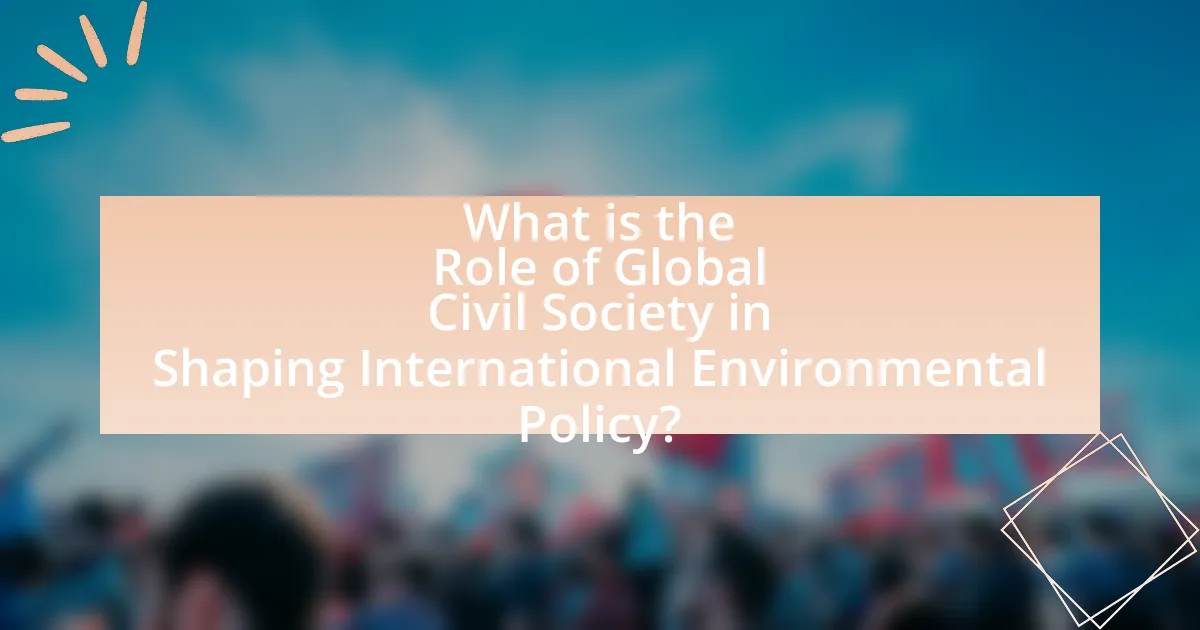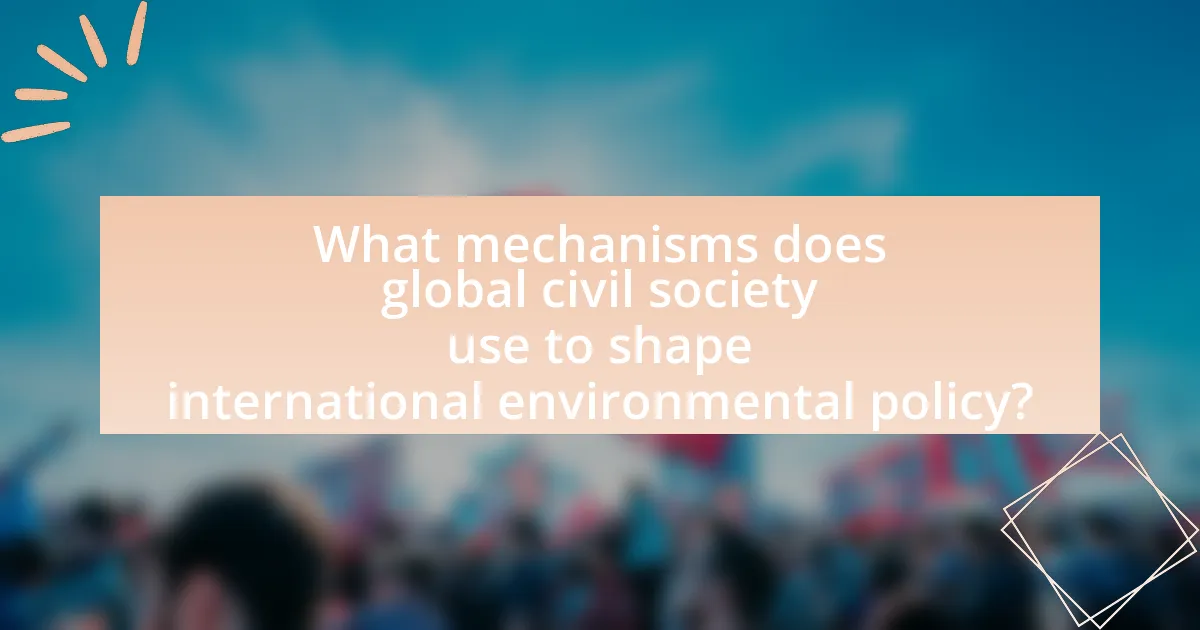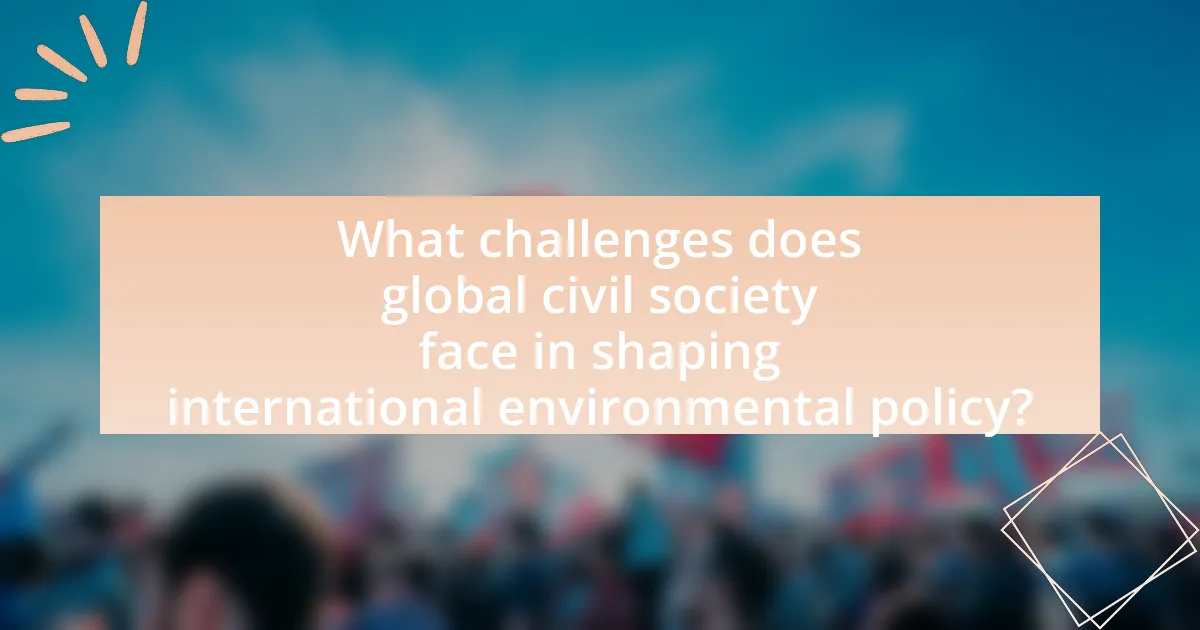Global civil society plays a vital role in shaping international environmental policy by advocating for sustainable practices, influencing governmental decisions, and raising public awareness. Key organizations such as Greenpeace, the World Wildlife Fund, and Amnesty International actively participate in international negotiations, providing expertise and representing marginalized voices. The article explores how these organizations mobilize public opinion, collaborate with governments, and utilize digital tools to enhance their advocacy efforts. It also addresses the challenges faced by civil society, including limited access to decision-making processes and the influence of powerful interests, while highlighting successful strategies and partnerships that have led to significant policy advancements like the Paris Agreement.

What is the Role of Global Civil Society in Shaping International Environmental Policy?
Global civil society plays a crucial role in shaping international environmental policy by advocating for sustainable practices, influencing governmental decisions, and mobilizing public awareness. Organizations within global civil society, such as non-governmental organizations (NGOs) and grassroots movements, actively participate in international negotiations, providing expertise and representing marginalized voices. For instance, the involvement of groups like Greenpeace and the World Wildlife Fund in the United Nations Framework Convention on Climate Change has led to significant policy advancements, including the Paris Agreement. Their efforts in raising awareness and pushing for accountability have been instrumental in promoting environmental justice and sustainability on a global scale.
How does global civil society influence environmental policy at the international level?
Global civil society influences environmental policy at the international level by mobilizing public opinion, advocating for policy changes, and participating in international negotiations. Organizations such as Greenpeace and the World Wildlife Fund engage in campaigns that raise awareness about environmental issues, thereby shaping public discourse and pressuring governments to adopt more stringent environmental regulations. For instance, the 2015 Paris Agreement saw significant input from civil society groups that highlighted the urgency of climate action, leading to commitments from countries to reduce greenhouse gas emissions. Additionally, global civil society often collaborates with intergovernmental organizations, providing expertise and grassroots perspectives that inform policy frameworks. This collaborative approach enhances the legitimacy and effectiveness of international environmental agreements, demonstrating the critical role of civil society in shaping global environmental governance.
What are the key organizations involved in global civil society?
Key organizations involved in global civil society include Amnesty International, Greenpeace, and the World Wildlife Fund (WWF). Amnesty International focuses on human rights advocacy, influencing international policies through campaigns and research. Greenpeace is dedicated to environmental protection and sustainability, actively engaging in campaigns that shape environmental policies globally. The WWF works on conservation efforts and sustainable development, collaborating with governments and businesses to promote environmental stewardship. These organizations collectively contribute to shaping international environmental policy through advocacy, research, and public engagement.
How do these organizations collaborate with governments and institutions?
Organizations collaborate with governments and institutions through partnerships, advocacy, and policy development. These collaborations often involve joint initiatives aimed at addressing environmental challenges, where organizations provide expertise and resources to support government efforts. For example, the United Nations Environment Programme (UNEP) works with various NGOs to implement environmental policies and programs, leveraging their on-the-ground knowledge and community engagement capabilities. Additionally, organizations participate in multi-stakeholder dialogues, such as the United Nations Framework Convention on Climate Change (UNFCCC), where they influence policy decisions by presenting research, data, and grassroots perspectives. This collaborative approach enhances the effectiveness of environmental policies by integrating diverse viewpoints and expertise.
Why is global civil society important for environmental advocacy?
Global civil society is important for environmental advocacy because it mobilizes diverse stakeholders to influence policy and raise awareness about environmental issues. This collective action amplifies the voices of marginalized communities and fosters global cooperation, which is essential for addressing transnational environmental challenges. For instance, organizations like Greenpeace and the World Wildlife Fund have successfully campaigned for international agreements, such as the Paris Agreement, demonstrating the effectiveness of civil society in shaping environmental policy. Additionally, research indicates that civil society organizations contribute to greater transparency and accountability in environmental governance, which enhances the legitimacy of policy decisions.
What unique perspectives does global civil society bring to environmental issues?
Global civil society brings diverse perspectives to environmental issues by integrating local knowledge, advocating for marginalized communities, and promoting global solidarity. This integration allows for a more comprehensive understanding of environmental challenges, as local communities often possess unique insights into their ecosystems. Advocacy for marginalized groups ensures that their voices are heard in policy discussions, which is crucial for equitable environmental governance. Furthermore, global solidarity fosters collaboration across borders, enabling the sharing of best practices and collective action against transnational environmental threats, such as climate change. These perspectives are essential for shaping inclusive and effective international environmental policies.
How does global civil society mobilize public opinion on environmental matters?
Global civil society mobilizes public opinion on environmental matters through advocacy, grassroots campaigns, and leveraging social media platforms. Organizations such as Greenpeace and the World Wildlife Fund engage in awareness-raising activities, often using data-driven reports to highlight environmental issues like climate change and biodiversity loss. For instance, the 2019 Global Climate Strike, organized by youth activists and supported by various civil society groups, drew millions of participants worldwide, demonstrating the power of collective action in shaping public discourse. Additionally, civil society groups utilize petitions and lobbying efforts to influence policymakers, as seen in the Paris Agreement negotiations where NGOs played a crucial role in pushing for stronger commitments from governments.

What mechanisms does global civil society use to shape international environmental policy?
Global civil society shapes international environmental policy through advocacy, networking, and participation in decision-making processes. Advocacy involves mobilizing public opinion and lobbying governments and international organizations to adopt sustainable practices and policies. Networking allows civil society organizations to collaborate and share information, amplifying their influence on policy discussions. Participation in decision-making processes, such as attending international conferences and contributing to negotiations, enables these organizations to directly impact policy outcomes. For instance, the involvement of NGOs in the United Nations Framework Convention on Climate Change has led to significant commitments from countries to reduce greenhouse gas emissions.
How do advocacy campaigns impact policy decisions?
Advocacy campaigns significantly influence policy decisions by mobilizing public opinion, raising awareness, and directly engaging policymakers. For instance, campaigns like the Global Climate Strike have successfully pressured governments to adopt more stringent environmental regulations, evidenced by the increased commitments to carbon neutrality from various nations following widespread public demonstrations. Additionally, research by the Pew Research Center indicates that 70% of Americans support stronger environmental protections, showcasing how advocacy efforts can shift public sentiment and, consequently, policy priorities.
What strategies are employed in successful advocacy campaigns?
Successful advocacy campaigns employ strategies such as building coalitions, utilizing data-driven messaging, and engaging in grassroots mobilization. Building coalitions allows diverse stakeholders to unite, amplifying their collective voice and increasing influence. Data-driven messaging ensures that arguments are supported by credible evidence, making them more persuasive; for instance, campaigns that effectively use statistics about climate change have been shown to resonate more with policymakers. Grassroots mobilization engages the public, fostering a sense of ownership and urgency around the issue, which can lead to increased pressure on decision-makers. These strategies have been validated by numerous successful campaigns, such as the global movement for climate action, which has effectively influenced international environmental policy.
How do grassroots movements contribute to policy change?
Grassroots movements contribute to policy change by mobilizing community engagement and raising awareness about specific issues, which pressures policymakers to respond. For instance, the environmental movement led by organizations like Greenpeace has successfully influenced legislation on climate change by organizing protests and campaigns that highlight the urgency of environmental protection. This grassroots activism has resulted in significant policy shifts, such as the adoption of the Paris Agreement in 2015, which was partly driven by public demand for action on climate change.
What role do partnerships play in influencing environmental policy?
Partnerships play a crucial role in influencing environmental policy by facilitating collaboration among diverse stakeholders, including governments, non-governmental organizations, and the private sector. These collaborations enhance the sharing of knowledge, resources, and best practices, which can lead to more effective and inclusive policy-making. For instance, the partnership between the United Nations Environment Programme and various civil society organizations has resulted in significant advancements in global environmental agreements, such as the Paris Agreement, which aims to combat climate change through collective action. This demonstrates that partnerships not only amplify voices but also drive the implementation of sustainable practices and policies at both national and international levels.
How do collaborations between civil society and international organizations enhance policy effectiveness?
Collaborations between civil society and international organizations enhance policy effectiveness by integrating diverse perspectives and expertise, which leads to more comprehensive and inclusive policy frameworks. Civil society organizations often possess grassroots knowledge and can identify local needs, while international organizations bring global standards and resources. This synergy facilitates the development of policies that are not only technically sound but also socially acceptable and contextually relevant. For instance, the partnership between the World Wildlife Fund and various local NGOs has resulted in successful conservation policies that consider both ecological sustainability and community livelihoods, demonstrating that such collaborations can yield effective and actionable environmental policies.
What examples illustrate successful partnerships in environmental advocacy?
Successful partnerships in environmental advocacy include the collaboration between the World Wildlife Fund (WWF) and Coca-Cola, which focused on sustainable water management. This partnership aimed to improve water efficiency and reduce the environmental impact of Coca-Cola’s operations, resulting in significant water conservation efforts. Another example is the partnership between the United Nations Environment Programme (UNEP) and various non-governmental organizations (NGOs) to promote the Global Environment Facility, which has funded over 4,500 projects in more than 170 countries, addressing issues like biodiversity and climate change. These partnerships demonstrate effective collaboration between corporations, governments, and civil society to achieve environmental goals.

What challenges does global civil society face in shaping international environmental policy?
Global civil society faces significant challenges in shaping international environmental policy, primarily due to limited access to decision-making processes and the influence of powerful state and corporate interests. These entities often prioritize economic growth over environmental sustainability, undermining the advocacy efforts of civil society organizations. Additionally, global civil society struggles with fragmentation and lack of coordination among diverse groups, which can dilute their collective impact. According to a report by the United Nations Environment Programme, effective participation of civil society is often hindered by bureaucratic barriers and insufficient funding, limiting their ability to engage in policy dialogues and advocacy campaigns.
What barriers hinder the effectiveness of global civil society?
Barriers that hinder the effectiveness of global civil society include limited funding, restrictive governmental policies, and lack of coordination among organizations. Limited funding restricts the ability of civil society organizations to implement projects and advocate effectively, as evidenced by a report from the Global Fund for Community Foundations, which highlights that many organizations operate on minimal budgets. Restrictive governmental policies, such as laws that limit the activities of NGOs, can stifle advocacy efforts, as seen in countries like Russia and Hungary where legislation has been enacted to control civil society activities. Additionally, lack of coordination among various organizations can lead to fragmented efforts and diluted impact, as noted in the 2018 report by the International Civil Society Centre, which emphasizes the need for collaboration to enhance effectiveness in addressing global issues.
How do political and economic factors impact civil society’s influence?
Political and economic factors significantly impact civil society’s influence by shaping the environment in which these organizations operate. Political stability, government policies, and legal frameworks determine the extent to which civil society can engage in advocacy and mobilization. For instance, in democratic regimes, civil society often enjoys greater freedom to operate and influence policy, as seen in countries like Sweden, where strong civil society organizations actively participate in environmental policy-making. Conversely, in authoritarian regimes, such as Belarus, civil society faces repression, limiting its ability to influence government decisions.
Economic factors also play a crucial role; funding availability and economic conditions can either empower or constrain civil society. For example, during economic downturns, civil society organizations may struggle to secure funding, reducing their capacity to advocate for environmental issues. In contrast, robust economic conditions can lead to increased philanthropic support for civil society initiatives, enhancing their influence on international environmental policy. Thus, the interplay of political and economic factors directly shapes the capacity and effectiveness of civil society in influencing policy outcomes.
What strategies can civil society adopt to overcome these challenges?
Civil society can adopt collaborative advocacy, grassroots mobilization, and strategic partnerships to overcome challenges in shaping international environmental policy. Collaborative advocacy involves uniting various stakeholders, including NGOs, community groups, and academic institutions, to amplify their voices and influence policy decisions effectively. Grassroots mobilization empowers local communities to engage in environmental issues, fostering a sense of ownership and responsibility towards sustainable practices. Strategic partnerships with governmental bodies and private sectors can leverage resources and expertise, enhancing the impact of civil society initiatives. For instance, the Global Climate Action Summit in 2018 showcased how civil society organizations partnered with governments to commit to ambitious climate goals, demonstrating the effectiveness of these strategies in driving policy change.
How does the digital landscape affect global civil society’s role?
The digital landscape enhances global civil society’s role by facilitating communication, mobilization, and advocacy on environmental issues. Through social media platforms and online networks, civil society organizations can rapidly disseminate information, engage a broader audience, and coordinate collective actions, which is crucial for influencing international environmental policy. For instance, the rise of digital campaigns, such as the #FridaysForFuture movement initiated by Greta Thunberg, demonstrates how online platforms can galvanize global youth activism and pressure policymakers. This increased connectivity allows civil society to hold governments and corporations accountable, thereby amplifying their impact on environmental governance.
What opportunities does social media provide for environmental advocacy?
Social media provides significant opportunities for environmental advocacy by enabling rapid information dissemination, fostering community engagement, and amplifying diverse voices. These platforms allow organizations and individuals to share real-time updates on environmental issues, mobilize support for campaigns, and raise awareness about climate change and conservation efforts. For instance, the hashtag #FridaysForFuture has mobilized millions globally, demonstrating how social media can effectively organize climate strikes and advocate for policy changes. Additionally, studies show that social media campaigns can increase public participation in environmental initiatives, as seen in the 2019 Global Climate Strike, which drew attention to climate action through widespread online engagement.
How can digital tools enhance collaboration among civil society organizations?
Digital tools enhance collaboration among civil society organizations by facilitating real-time communication, information sharing, and project management. These tools, such as collaborative platforms and social media, enable organizations to coordinate efforts, share resources, and mobilize support more effectively. For instance, a study by the International Association for the Study of the Commons found that digital platforms significantly increased the ability of civil society organizations to engage in collective action, leading to more impactful environmental advocacy. This demonstrates that the integration of digital tools can streamline processes and amplify the voices of civil society in shaping international environmental policy.
What best practices can global civil society adopt to enhance their impact on international environmental policy?
Global civil society can enhance their impact on international environmental policy by fostering collaboration among diverse stakeholders, including governments, businesses, and local communities. This collaborative approach allows for the pooling of resources, knowledge, and expertise, which can lead to more effective advocacy and policy formulation. For instance, the Global Climate Action Summit in 2018 demonstrated how partnerships between civil society organizations and governmental bodies can drive significant climate initiatives, showcasing the power of collective action. Additionally, leveraging data and research to inform policy recommendations can strengthen the credibility of civil society’s positions, as evidenced by the Intergovernmental Panel on Climate Change’s reports that have influenced global climate negotiations. Engaging in grassroots mobilization and raising public awareness can also amplify voices and pressure policymakers to prioritize environmental issues, as seen in movements like Fridays for Future.
How can civil society organizations effectively measure their influence on policy outcomes?
Civil society organizations can effectively measure their influence on policy outcomes by utilizing a combination of quantitative and qualitative metrics, such as tracking policy changes, analyzing legislative outcomes, and conducting stakeholder surveys. For instance, organizations can assess the number of policies influenced or adopted as a direct result of their advocacy efforts, which provides concrete evidence of their impact. Additionally, analyzing media coverage and public discourse surrounding specific policies can reveal shifts in public opinion and awareness, further indicating the organization’s influence. Research has shown that organizations that systematically document their advocacy efforts and outcomes, such as through case studies or impact assessments, can provide compelling evidence of their effectiveness in shaping policy.
What lessons can be learned from successful case studies in environmental advocacy?
Successful case studies in environmental advocacy demonstrate the importance of community engagement and collaboration. For instance, the success of the “Save the Redwoods League” in California highlights how grassroots mobilization can lead to significant policy changes, resulting in the protection of over 200,000 acres of redwood forests. This case illustrates that building strong local coalitions and fostering public awareness are crucial for effective advocacy. Additionally, the “Fridays for Future” movement showcases the power of youth activism in influencing global climate policy, as it has successfully pressured governments to commit to more ambitious climate goals. These examples underscore that strategic communication, leveraging social media, and forming alliances with diverse stakeholders are essential tactics in environmental advocacy.